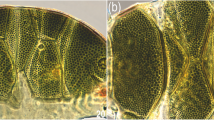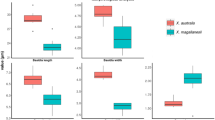Abstract
Taxonomic studies on scolopendrid centipedes have often documented variability at the individual and population levels and applied those data to questions of species delimitation, but these investigations have mostly lacked an explicit phylogenetic framework. A molecular phylogeny and recent taxonomic revision for Indian species of the scolopendrid Digitipes Attems, 1930, permit variability of traditional taxonomic characters for Scolopendridae to be mapped onto a phylogeny. Based on their fit to the tree using maximum likelihood, reliable species-level characters include the number of glabrous antennal articles, presence of a median ridge on the tergites, and presence or absence of a tarsal spur on leg 20. Characters that are conserved within and diagnostic for particular species but labile within others (typically with geographic structure) include the first tergite with paramedian sutures, presence or absence of a lateral spine on the coxopleuron, and the number of spines in a ventromedial row on the ultimate leg prefemur. Comparisons with published accounts of variability in species of other scolopendrid genera, particularly Scolopendra and Otostigmus, show that Indian Digitipes has conserved morphology in some characters that are taxonomically useful elsewhere in the family, and most of its taxonomically informative characters have analogous patterns of variability in other genera. The approach used in this study to evaluate morphological variation in a phylogenetic framework can be applied to other taxa in which morphologically cryptic species have been reported and where species diagnosis requires a combination of characters.













Similar content being viewed by others
References
Attems, C. (1930). Myriapoda 2. Scolopendromorpha. In F. E. Schulze & W. Kükenthal (Eds.), Das Tierreich, 54 (pp. 1–308). Berlin: Walter de Gruyter.
Bickford, D., Lohman, D. J., Sodhi, N. S., Ng, P. K., Meier, R., Winker, K., Ingram, K. K., et al. (2007). Cryptic species as a window on diversity and conservation. Trends in Ecology & Evolution, 22, 148–155.
Bonato, L., Edgecombe, G. D., Lewis, J. G. E., Minelli, A., Pereira, L. A., Shelley, R. M., & Zapparoli, M. (2010). A common terminology for the external anatomy of centipedes (Chilopoda). ZooKeys, 69, 17–51.
Füller, H. (1963). Vergleichende Untersuchungen über das Skelettmuskelsystem der Chilopoden. Abhandlungen der deutschen Akademie der Wissenschaften zu Berlin, Klasse für Chemie, Geologie und Biology, Jahrgang, 1962(3), 1–98.
Ihaka, R., & Gentleman, R. (1996). R: a language for data analysis and graphics. Journal of Computational and Graphical Statistics, 5, 299–314.
Jangi, B. S., & Dass, C. M. (1984). Scolopendridae of the Deccan. Journal of Scientific and Industrial Research, 43, 27–54.
Joshi, J., & Edgecombe, G. D. (2013). Revision of the scolopendrid centipede Digitipes Attems, 1930, from India (Chilopoda: Scolopendromorpha): reconciling molecular and morphological estimates of species diversity. Zootaxa, 3626, 99–145.
Joshi, J., & Karanth, K. P. (2012). Coalescent method in conjunction with niche modelling reveals cryptic diversity among centipedes in the western Ghats of South India. PloS One, 7, e42225.
Joshi, J., & Karanth, P. (2013). Did southern western Ghats of peninsular India serve as refugia for its endemic biota during the Cretaceous volcanism? Ecology and Evolution, 3, 3275–3282.
Kraepelin, K. (1903). Revision der Scolopendriden. Jahrbuch der Hamburgischen wissenschaftlichen Anstalten, 20(2), 1–276.
Kraus, O. (1957). Einekleine Myriapoden-Ausbeuteaus Katanga (Belgisch Congo). Revue de Zoologie et de Botanique Africaines, 55, 396–404.
Lewis, J. G. E. (1967). The scolopendromorph centipedes of the Sudan with remarks on taxonomic characters in the Scolopendridae. Proceedings of the Linnean Society London, 178, 185–207.
Lewis, J. G. E. (1968). Individual variation in a population of the centipede Scolopendra amazonica from Nigeria and its implications for methods of taxonomic discrimination in the Scolopendridae. Journal of the Linnean Society (Zoology), 47, 315–326.
Lewis, J. G. E. (1969). The variation of the centipede Scolopendra amazonica in Africa. Zoological Journal of the Linnean Society, 48, 49–57.
Lewis, J. G. E. (1978). Variation in tropical scolopendrid centipedes: problems for the taxonomist. Abhandlungen und Verhandlungen des naturwissenschaftlichen Vereins in Hamburg, NF, 21/22, 43–50.
Lewis, J. G. E. (2000). Variation in three centipede species of the genus Otostigmus and its bearing on species discrimination (Chilopoda; Scolopendromorpha; Scolopendridae). Journal of Natural History, 34, 433–448.
Lewis, J. G. E. (2003a). The problems involved in the characterisation of scolopendromorph species (Chilopoda: Scolopendromorpha). African Invertebrates, 44, 61–69.
Lewis, J. G. E. (2003b). On the identity of the various taxa that have been assigned to Otostigmus (O.) politus Krasch, 1881 and forms related thereto (Chilopoda: Scolopendromorpha). Arthropoda Selecta, 12, 1930–1206.
Lewis, J. G. E. (2010). A revision of the rugulosus group of Otostigmus subgenus Otostigmus Porat, 1876 (Chilopoda: Scolopendromorpha: Scolopendridae). Zootaxa, 2579, 1–29.
Lewis, J. G. E. (2015). On Verhoeff’s Otostigmus subgenus Malaccopleurus, the nudus group of Otostigmus subgenus Otostigmus Porat, 1876, and Digitipes Attems, 1930, with a description of the foetus stadium larva in O. sulcipes Verhoeff, 1937, (Chilopoda: Scolopendromorpha: Scolopendridae). Zootaxa, 4039, 225–248.
Kawakita, A., Sota, T., Ito, M., Ascher, J. S., Tanaka, H., Kato, M., & Roubik, D. W. (2004). Phylogeny, historical biogeography, and character evolution in bumble bees (Bombus: Apidae) based on simultaneous analysis of three nuclear gene sequences. Molecular Phylogenetics and Evolution, 31, 799–804.
Machado, C. A., Jousselin, E., Kjellberg, F., Compton, S. G., & Herre, E. A. (2001). Phylogenetic relationships, historical biogeography and character evolution of fig-pollinating wasps. Proceedings of the Royal Society B: Biological Sciences, 268, 685–694.
Michalik, P., & Rittschof, C. C. (2011). A comparative analysis of the morphology and evolution of permanent sperm depletion in spiders. PloS One, 6, e16014.
Oliver, J. C., Robertson, K. A., & Monteiro, A. (2009). Accommodating natural and sexual selection in butterfly wing pattern evolution. Proceedings of the Royal Society B: Biological Sciences, 276, 2369–2375.
Paradis, E., Claude, J., & Strimmer, K. (2004). APE: analyses of phylogenetics and evolution in R language. Bioinformatics, 20, 289–290.
Siriwut, W., Edgecombe, G. D., Sutcharit, C., & Panha, S. (2015a). The centipede genus Scolopendra in mainland Southeast Asia: molecular phylogenetics, geometric morphometrics, and external morphology as tools for species delimitation. PloS One, 10, e0135355.
Siriwut, W., Edgecombe, G. D., Sutcharit, C., Tongkerd, P., & Panha, S. (2015b). First record of the African-Indian centipede genus Digitipes Attems, 1930 (Scolopendromorpha: Otostigminae) from Myanmar, and the systematic position of a new species based on molecular phylogenetics. Zootaxa, 3931(1), 71–87.
Siriwut, W., Edgecombe, G. D., Sutcharit, C., Tongkerd, P., & Panha, S. (2016). A taxonomic review of the centipede genus Scolopendra Linnaeus, 1758 (Scolopendromorpha, Scolopendridae) in mainland Southeast Asia, with description of a new species from Laos. ZooKeys, 590, 1–124.
Stamatakis, A., Ludwig, T., & Meier, H. (2005). RAxML-III: a fast program for maximum likelihood-based inference of large phylogenetic trees. Bioinformatics, 21, 456–463.
Zaldivar-Riverón, A., Belokobylskij, S. A., León-Regagnon, V., Briceño-G, R., & Quicke, D. L. J. (2008). Molecular phylogeny and historical biogeography of the cosmopolitan parasitic wasp subfamily Doryctinae (Hymenoptera: Braconidae). Invertebrate Systematics, 22, 345–364.
Acknowledgements
This collaboration was supported by a Royal Society International Exchange. We thank the Forest Departments of Kerala, Karnataka, and Goa for granting permission to collect in their forest areas; and Council for Scientific and Industrial Research and Ministry of Environment and Forests for funding the field excursions and molecular work. JJ would like to thank Dr. Praveen Karanth for useful discussions and encouragement to pursue this work. Dr. John Lewis advised on various taxonomic characters, and the journal’s referees provided useful suggestions that substantially improved the manuscript.
Author information
Authors and Affiliations
Corresponding author
Rights and permissions
About this article
Cite this article
Joshi, J., Edgecombe, G.D. Tracking the variability of phenotypic traits on a molecular phylogeny: an example from scolopendrid centipedes in peninsular India. Org Divers Evol 17, 393–408 (2017). https://doi.org/10.1007/s13127-017-0323-9
Received:
Accepted:
Published:
Issue Date:
DOI: https://doi.org/10.1007/s13127-017-0323-9




